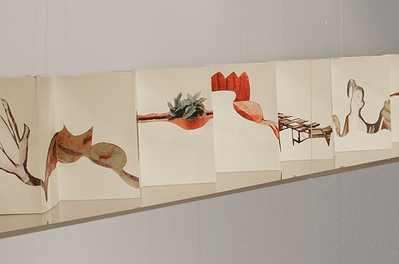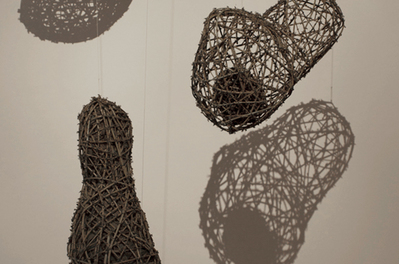Found Redux
by Bansie Vasvani
The current exhibition continuing through August 23rd at the Talwar Gallery, New York, entitled Found, features the work of Indian and Sri Lankan artists Aishya Abraham, Muhanned Cader, and Srinivas Prasad. Grouped together for the first time for their use of found materials, these artists communicate in a language that speaks beyond the context of their immediate surroundings. Their visions converge in presentations appealing to universal feelings for time and history, and they stir a strong sense of nostalgia.
Ayisha Abraham’s grainy, amateur videos En Route or Of a Thousand Moons, 2011, gathered from discarded family archives, offer little in terms of actual documentation of time, place or history. Segments from various videos are presented in a seamless trajectory deliberately without reference to any specific tale or narrative. What emerges from these disparate montages of found footage is reference to irretrievable moments of bygone years—simple pleasures derived from family gatherings, children growing up, family excursions and travel. These tug at one’s basic nostalgic feelings for a period of past tranquility. The disjointed capsules require viewers to fill in the gaps in the film to create a cohesive narrative and language. Yet the lack of specificity of time or place has a transformative power as these decontexualized segments compel a connection between the past and present, memory and imagination. This new landscape comprising various ahistorical familial bonds draws upon a revitalized sense of life and energy that appeals across borders and cultures.

Aiysha Abraham | En route or of a Thousand Moons | Found 8mm Films transferred to DVD, Sound | 19 min, 42 sec | 2011 | Image courtesy of Deepak Talwar Gallery
Cader’s collages consist of images acquired from magazines across different genres and time periods to create strangely surreal forms. Often humorous and deeply engaging, each shape morphs from alluding to hidden meanings in its original context toward engagement with the new images as they emerge; that is, Cader’s reshaped forms of skyscrapers, landscapes, interior design, furniture and objects alter our perception as we see small parts of the whole. They recall historical sources sparingly. Images presented in an accordion format in Fan Book Collage, 2013, are reminiscent of a small diary filled with personal references known only to the author of the work. . As art historian Sharmini Pereira points out, “Details excavated from their original moorings” (1) pique one’s curiosity and imagination about the relationship between what is discarded and what is used. Most importantly, Cader does not use “abstraction as a pure end in itself” (2), instead to excerpt the form from its original context so that it does not resemble anything specific.

Muhanned Cader | Untitled (Detail) | Fan book collage | 5.5” x 3.5” x 78” | 2013 | Image courtesy of Deepak Talwar Gallery
Cader’s collages takes us back to an imagined moment before “form and meaning were aligned into perfect registration.” (3) His work has been concerned with the non-linguistic representation of objects and ideas—forms that appeal to us before language—drawing us towards a deeper level that lies between language and imagery. The lack of frames in his art is in keeping with his belief that “truth or knowledge appears in fragments, mere parts of a larger, if intangible, whole.” (4)
Srinivas Prasad’s photographs of his outdoor installations and organic oval shapes, Gudu, 2013, as it is hung in the gallery, immediately recall birds’ nests, germination and the cycle of life. Inspired by his childhood in rural India, Prasad’s work is steeped in the use of natural materials and the rituals of farming. He uses thin strips of bamboo, steel wire, and Acacia leaves to create complex organic architectural structures in nature. These installations reverberate with the profound rhythms and tenuousness of life captured through the tactility and delicacy of the organic components. One is compelled to experience the physical and emotive potency of the work in a multi-sensory way. Both Cader and Prasad show a personal aesthetic and philosophical positioning in the way their works are put together—Cader for his unique shapes and forms that are deeply suggestive, and Prasad for the weightiness of his seemingly simple structures.

Srinivasa Prasad | Gudu (Detail) | Bamboo, Steel wire and Acacia leaves | Dimensions Variable (work in 3 parts) | 2013 | Image courtesy of Deepak Talwar Gallery
The exhibition enriches. Its expressive and aesthetic media encourage the act of looking and pondering. Through this process of contemplation one is transported beyond language, national boundaries, politics, and dogmas, toward some essentially shared human existence.
(1) http://www.rakingleaves.org/artists/
(2) http://www.rakingleaves.org/artists/
(3) ibid
(4) ibid
